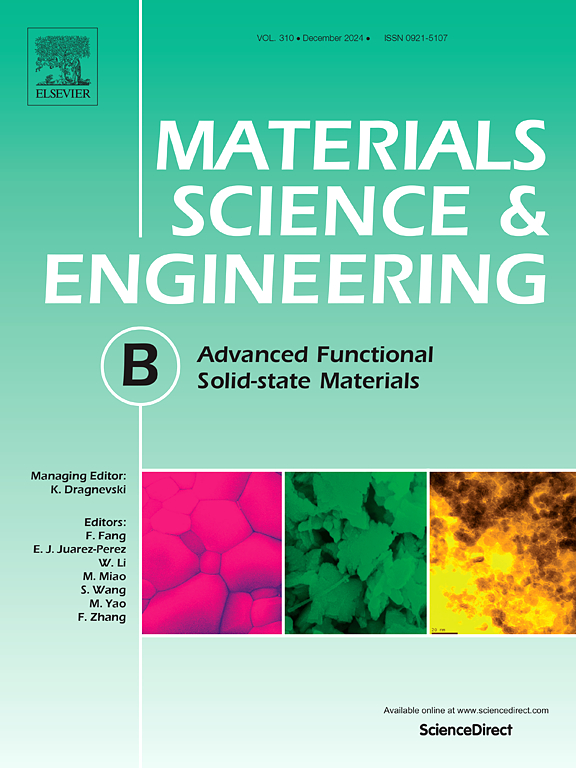A comprehensive study on the impact of Al doping on the micro-structural, optical and magnetic characteristics of greenly synthesized AlxTi1-xO2 (x = 0.03–0.15) UFNPs
IF 3.9
3区 材料科学
Q2 MATERIALS SCIENCE, MULTIDISCIPLINARY
引用次数: 0
Abstract
This study investigates the impact of Al+3 doping on the micro-structural, optical and magnetic properties of Ti1-xAlxO2 ultrafine nanoparticles (UFNPs), synthesized via fresh sugarcane juice mediated green self-combustion facile reactions. Formation of Ti1-xAlxO2 UFNPs in the phase pure anatase type tetragonal symmetry (space group: I41/amd) was confirmed by powder Χ-ray diffraction (PXRD), Rietveld refinement, selected area electron diffraction (SAED), high resolution transmission electron microscopy (HR-TEM) and Raman analysis. The HR-TEM analysis revealed good crystallinity of these Ti1-xAlxO2 UFNPs with a quite narrow size distribution of nearly spherical nanoparticles in the 5–7 nm size range. Broadening and positional shifts are observed in the Raman Eg(1) mode, which are characteristic signature of lattice disorder and presence of defect in the lattice. The lattice disorderness and vacancy induced effect can be attributed to mismatch in the ionic size and valance state of Al+3 and Ti+4 ions. Notably, a good fit to the Raman Eg(1) mode with phonon confinement model (PCM) and Breit-Wigner-Fano (BWF) models validates presence of various defects in the anatase lattice. Specifically, the correlation length (L), representing the distance between nearest oxygen vacancies, increases, while the asymmetry parameter decreases monotonically as the content of Al+3 ions in TiO2 UFNPs is raised. FTIR spectra of Ti1-xAlxO2 UFNPs exhibited remarkable similarity across all samples, with consistent band assignments indicating good solubility of Al+3 ions in the anatase lattice and also suggests that varying Al+3 concentrations do not significantly alter the overall chemical environment in TiO2 UFNPs. UV–Vis-NIR absorption data showed strong light absorption below 400 nm in the blue-UV region and good transparency to visible band along with a redshift in the optical absorption edge with Al+3 content. Ti1-xAlxO2 UFNPs exhibited semiconducting character as their direct bandgap energies are significantly lower than that of undoped TiO2 UFNPs (Eg = 3.38 eV), which progressively decreases to Eg = 2.96 eV for Ti0.85Al0.15O2. Photoluminescence (PL) and electron paramagnetic resonance (EPR) analyses demonstrated that incorporating Al+3 ions in the TiO2 lattice generates defects, such as F+ centers and oxygen vacancies due to creation of Ti+3 ions by replacement of Ti+4 ions by Al+3 ions along with electronic transitions from Ti+3 to TiO62- octahedra. Noticeably, doping of non-magnetic Al+3 ions in Ti1-xAlxO2 UFNPs resulted in a well-defined magnetic hysteresis loop with monotonic increase in the coercivity and marginal change in the remanent and saturation magnetization. The study concludes that single-electron oxygen vacancies mediate s-d exchange interactions and Ti+3-V0-Ti+3 interactions drive the formation of bound magnetic polarons (BMPs). Overlapping of BMPs facilitate the weak d0 type ferromagnetic order in Ti1-xAlxO2 UFNPs.
求助全文
约1分钟内获得全文
求助全文
来源期刊

Materials Science and Engineering: B
工程技术-材料科学:综合
CiteScore
5.60
自引率
2.80%
发文量
481
审稿时长
3.5 months
期刊介绍:
The journal provides an international medium for the publication of theoretical and experimental studies and reviews related to the electronic, electrochemical, ionic, magnetic, optical, and biosensing properties of solid state materials in bulk, thin film and particulate forms. Papers dealing with synthesis, processing, characterization, structure, physical properties and computational aspects of nano-crystalline, crystalline, amorphous and glassy forms of ceramics, semiconductors, layered insertion compounds, low-dimensional compounds and systems, fast-ion conductors, polymers and dielectrics are viewed as suitable for publication. Articles focused on nano-structured aspects of these advanced solid-state materials will also be considered suitable.
 求助内容:
求助内容: 应助结果提醒方式:
应助结果提醒方式:


